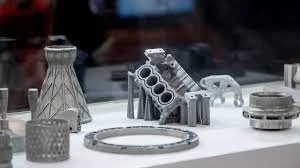Metal Magic engraves brass and copper dies to create everything from commercial packaging to trading cards.
Powder bed fusion technologies are the most commonly used methods for printing with metals. These machines sinter or melt metal powder particles together to build up parts layer by layer.
Selective laser melting and direct metal laser sintering are two of the major powder bed fusion processes available. There is also a new printer called binder jetting that may soon eclipse the other processes.
How 3D Metal Printing Works
3D metal printing is a type of additive manufacturing that uses digital data to build components layer by layer from metallic powders. The process eliminates the design constraints of traditional fabrication methods, making it well-suited to a wide range of applications from prototyping to full production of high-criteria metal parts.
The main differentiator between additive and conventional fabrication techniques is that metal printing enables designers to use more complex shapes and geometries without increasing the cost. The process also eliminates many machining steps that are native to most other fabrication methods. With little to no programming or preparation work, and no tool paths to set up, the costs associated with metal printing are largely driven by part size rather than complexity.
Typically, the higher the temperature used during the fusing process, the stronger the final printed part will be. For this reason, it is common to find parts that are designed to be used in demanding environments made from high-performance alloys such as titanium, cobalt-chrome and nickel-cobalt. Nevertheless, it is important to understand that such printed parts can still experience cyclic stress and fatigue.
Getting Started
Once you have a suitable printer and the correct printing filament or powder, the possibilities become nearly endless. As technology advances, the list of materials capable of being printed will continue to expand, opening up new applications and making metal 3D printing more accessible for the manufacturing masses.
Currently, the four most common metals for 3D printing are titanium, stainless steel, cobalt and nickel. These metals offer excellent strength, resistance to corrosion and good aesthetics. The best metal for your project depends on your application. For example, if you want a strong, lightweight part then you should use a titanium alloy like ti6Al4V. Stainless steel, on the other hand, offers high corrosion resistance and good fatigue properties.
The most popular 3D printers for printing in metal are Selective Laser Melting (SLM), Electron Beam Melting (EBM) and Directed Energy Deposition (DED). These techniques differ in how the material is deposited onto the part.
Designing a Part
As the only additive manufacturing technology to make parts out of metal, 3D printing has become a key tool for designers. It is now possible to create fully functional end parts in a fraction of the time it takes with traditional methods and at a much lower cost. This has made it a popular choice for prototyping, but also to reduce the amount of machining required and eliminate the need for complex and expensive machine tools, all while allowing engineers to compress product development cycles and get to market faster.
A variety of materials are available for printing with 3D metal printing services, including aerospace-grade aluminum alloys (such as AA6061) and stainless steels (such as 316L). The choice of material depends on the mechanical properties required for the part. A variety of post-processing techniques are also available to modify the surface finish of the part as needed.
Printing a Part
Printing a metal part using 3D printing technology involves many steps. First, the printer loads a specific amount of metal powder. It then builds the part layer by layer. As it prints, the machine uses heat and light to fuse the particles together. This process is called melting and sintering. The printed parts are a little rough. The roughness is due to the printing process itself and the way the powder is deposited on the printed surface. This roughness is typically not a problem for most applications.
A number of different metal 3D printing technologies are available, including SLM (selective laser melting), EBM (electron beam melt) and DED (direct energy deposition). There are also other techniques such as binder jetting and bound powder extrusion. However, SLM and EBM are the most popular technologies for printing metal parts.



